10.10.2024
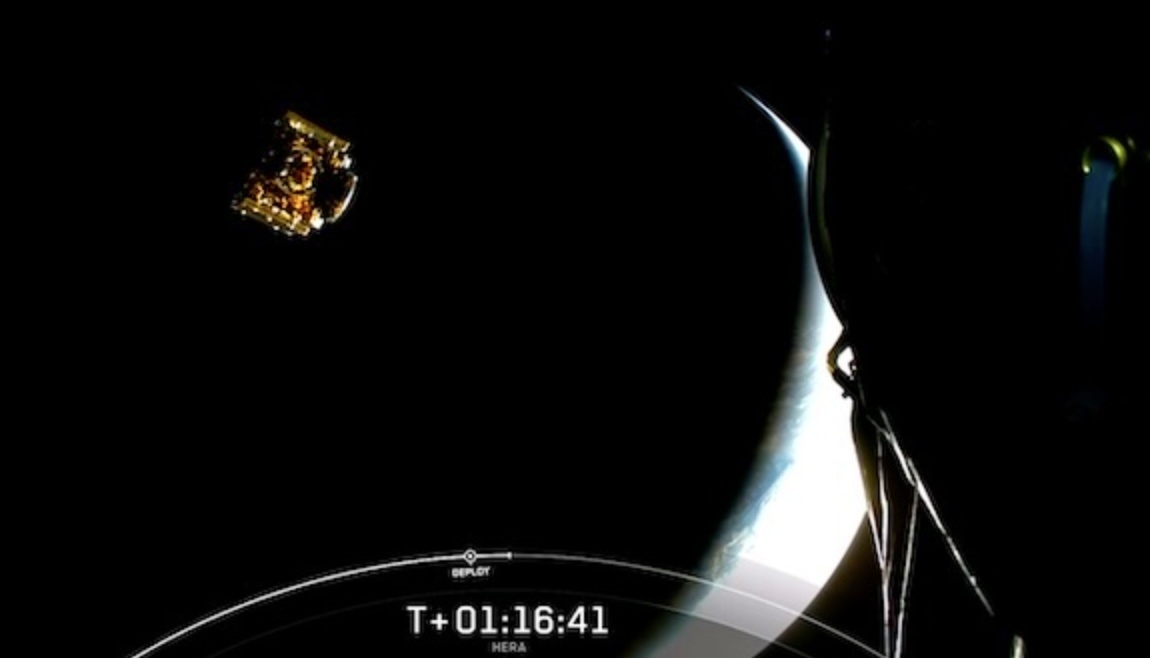
ESA Launches Probe to Revisit Asteroid Crime Scene
Europe's Hera mission will examine the results of NASA's DART planetary defense test
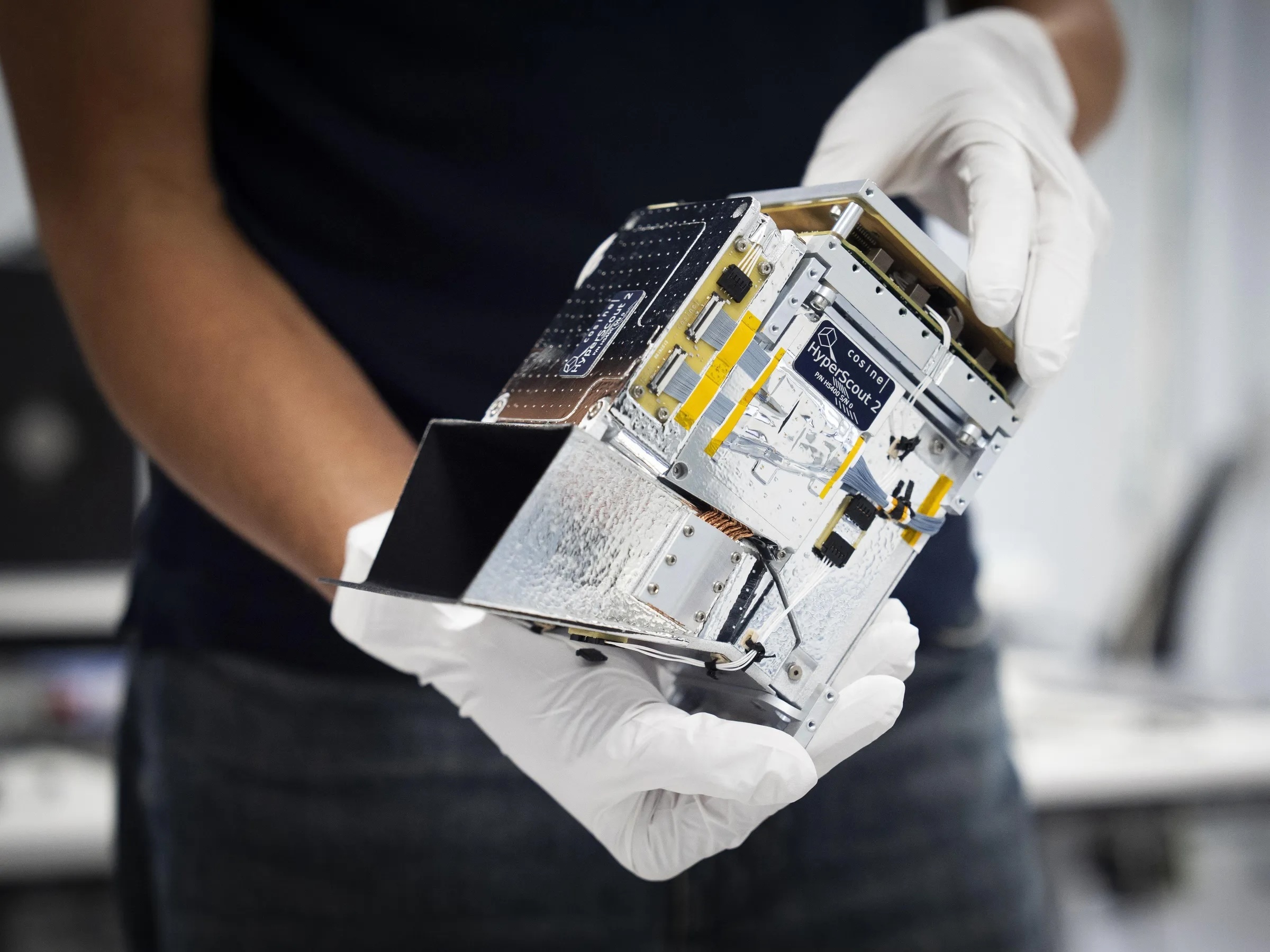
This hyperspectral imager will take pictures in visible and infrared wavelengths during Hera's mission to Didymos and Dimorphos.
The European Space Agency’s Hera spacecraft is en route to assess how NASA’s 2022 DART mission impacted the asteroid Dimorphos. DART smashed into the asteroid at a little over 6 kilometers per second, sending out a cloud of debris and slowing it slightly. Hera’s detailed post-collision survey aims to tell us just how efficient the kinetic impact was. This will inform the design of planetary defense missions, should we need to defend Earth from an asteroid threat.
A SpaceX Falcon 9 rocket carrying Hera lifted off from Cape Canaveral on 7 October and is now on a journey, via a flyby of Mars in 2025, to asteroid Didymos and its minute moon Dimorphos. Arrival at the binary asteroid system is scheduled for December 2026.
DART impacted the 151-meter-diameter Dimophos back in 2022, reducing its velocity by 2.7 millimeters per second and thus, over time, changing its orbit around the Sun. There are, however, still many things to learn about the DART impact and its target before its kinetic impactor technique could be used in earnest against an incoming asteroid. “We need to measure the mass of Dimorphos to know how efficient the impact technique actually is, to offer any future use,” says Michael Kueppers, a project scientist with ESA, said during a press briefing on 2 October.
“It’s the first time that CubeSats will operate autonomously around another body.” —MICHAEL KUEPPERS, ESA
The Hera mission cost is €363 million (US $398 million). The spacecraft was built within a tight four-year timeline, despite the COVID-19 pandemic, and involved 18 European countries. It carries a suite of 12 payloads and will investigate any crater formation or deformation of the asteroid caused by DART and provide insights into how energy from the impact was distributed and better understand the impact process. It will also assess the asteroid’s internal structure and the local environment and debris field. This debris could, incidentally, later result in meteor showers at Mars and even reach Earth.
Hera is then “going back to the crime site and getting all of the scientific and technical information about these asteroids to validate our physical models,” Ian Carnelli, Hera Project Manager at ESA, said during the briefing.
How Hera Will Study an Asteroid
Getting up close and assessing the asteroids will not be straightforward, however. As Dimorphos’s gravity is negligible, at approximately 200,000 times weaker than Earth’s, the spacecraft will not orbit the asteroid in the usual sense. Hera will operate around the binary system’s combined center of gravity, or barycenter, leveraging techniques from the Rosetta mission, which visited Comet 67P/Churyumov-Gerasimenko a decade ago. This will see it use a series of hyperbolic arcs 20 to 30 kilometers out, to get a global picture, determine mass, and understand thermal and dynamic properties. Then, matters will get more complex.
Hera will deploy two CubeSats, Milani and Juventas, to complement the study after about four weeks at the Didymos system. “For the first time, we will investigate such a body with three spacecraft in parallel,” says Kueppers. “And it’s the first time that CubeSats will operate autonomously around another body.”
Milani carries a hyperspectral imager and a dust and volatiles detector. Juventas carries a radar which will map the asteroid’s internal structure. Both use cold gas propulsion. The trio will embark on ever-closer flybys of Dimorphos, eventually returning images of selected areas with a resolution of 10 centimeters.
After achieving their main science objectives, Milani and Juventas will attempt landings on Dimorphos. The pair are not engineered for landing, but will approach with relative velocities of centimeters per second and, hopefully, continue operations once on the surface. Likewise, Hera could land on the larger Didymos asteroid at the end of its six-month primary mission. The details of this are still being worked out, says Kueppers.
The orbital challenges will also present opportunities. While designed to be fully operated by ground teams, Hera will have a high degree of onboard autonomy, using a range of data to determine the environment and react in a way similar to a self-driving car. One navigation mode is autonomous feature tracking, which will see Hera image boulders and craters to judge the spacecraft’s attitude and trajectory relative to the asteroid. This will be tested out fully once Hera’s primary objectives are complete.
Hera will pave the way for future endeavors in more ways than just its science return. The mission came in under budget, Carnelli noted, and the savings have, fittingly, been redirected for more asteroid adventures. The funds have allowed the start of the Ramses mission, a stripped-down version of Hera, that will fly out to meet infamous asteroid Apophis when it makes an approach to within 32,000 km of Earth in 2029. Together, Hera, DART, and future missions will help us develop the tools to protect Earth from threats in our cosmic neighborhood.
Hera takes flight: Didymos, here we come
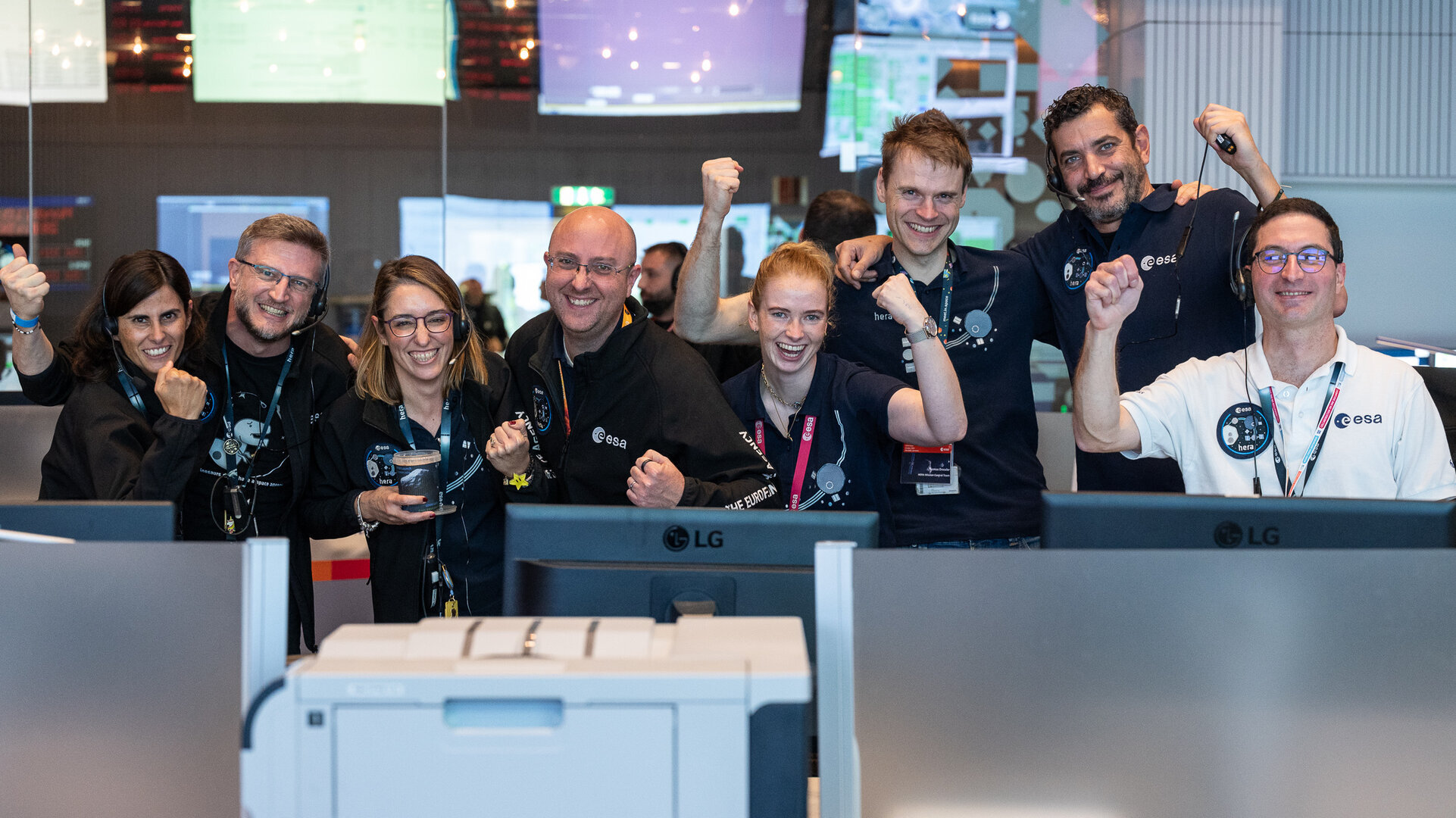
The day began with an 85% chance that bad weather would cause a launch delay: it ended with ESA’s Hera mission successfully in space and en route to the Didymos binary asteroid system.
At 16:52 CEST (14:52 UTC) on 7 October 2024, Hera took to the skies aboard a SpaceX Falcon 9 rocket from Cape Canaveral Space Force Station in Florida, USA. After a smooth 76-minute ascent, the spacecraft separated from its launcher, and, a few minutes later, ESA’s ESOC mission operations centre in Germany assumed control of the spacecraft.
Here is what has happened since then.
Hera’s first days in space

The first telemetry form Hera arrived on Earth via NASA’s Goldstone station at 18:12 CEST and confirmed the spacecraft’s successful separation from the launcher.
By 18:24 CEST, both of Hera’s 5 m solar arrays had deployed and the spacecraft had begun to generate power.
ESA’s Flight Dynamics team quickly confirmed that the SpaceX launcher had delivered Hera into the correct orbit and mission controllers began activating the spacecraft's other core systems.
Over the next 54 hours, Hera powered on and tested its star trackers (used for navigation) and its reaction wheels (used to control Hera’s orientation in space).

Mission control also tested the communication antennas that Hera will use to stay in touch with Earth via ESA’s Estrack ground station network and conducted a successful thruster test, during which each thruster was fired briefly to ensure proper functionality ahead of Hera’s upcoming deep space manoeuvre.
“It has been an action-packed few days,” says Sylvain Lodiot, Hera Spacecraft Operations Manager. “We have fine-tuned some of the systems, but overall, Hera’s first days in space have gone very well. The hardware is performing well, and we have already uplinked a few software updates.”
What’s next for Hera?

Hera is now already more than a million kilometres from Earth. Over the next few weeks, the spacecraft’s suite of scientific instruments will be gradually powered on and tested. These instruments will collect valuable data about Didymos and its moonlet, Dimorphos, once Hera arrives at the binary asteroid system in late 2026. In particular, Hera will help scientists better understand the structure of Dimorphos and how it was altered by NASA’s DARTmission, which deliberately crashed into the asteroid in 2022 in the first test of asteroid deflection.
Hera will also study how binary asteroid systems like Didymos form and function. As the first spacecraft to rendezvous with a binary asteroid system, Hera will provide unique insight into these celestial bodies, which account for around 15% of all known asteroids.
Hera’s first deep space manoeuvre will begin in late October and put the spacecraft on course for its next major milestone, a flyby of Mars in March 2025. During this flyby, Hera will use its instruments to study Deimos, the smaller and more enigmatic of Mars’s two moons. This will serve as an important test for many of the spacecraft’s instruments, ensuring they are fully operational before the spacecraft arrives at its final destination, Didymos.

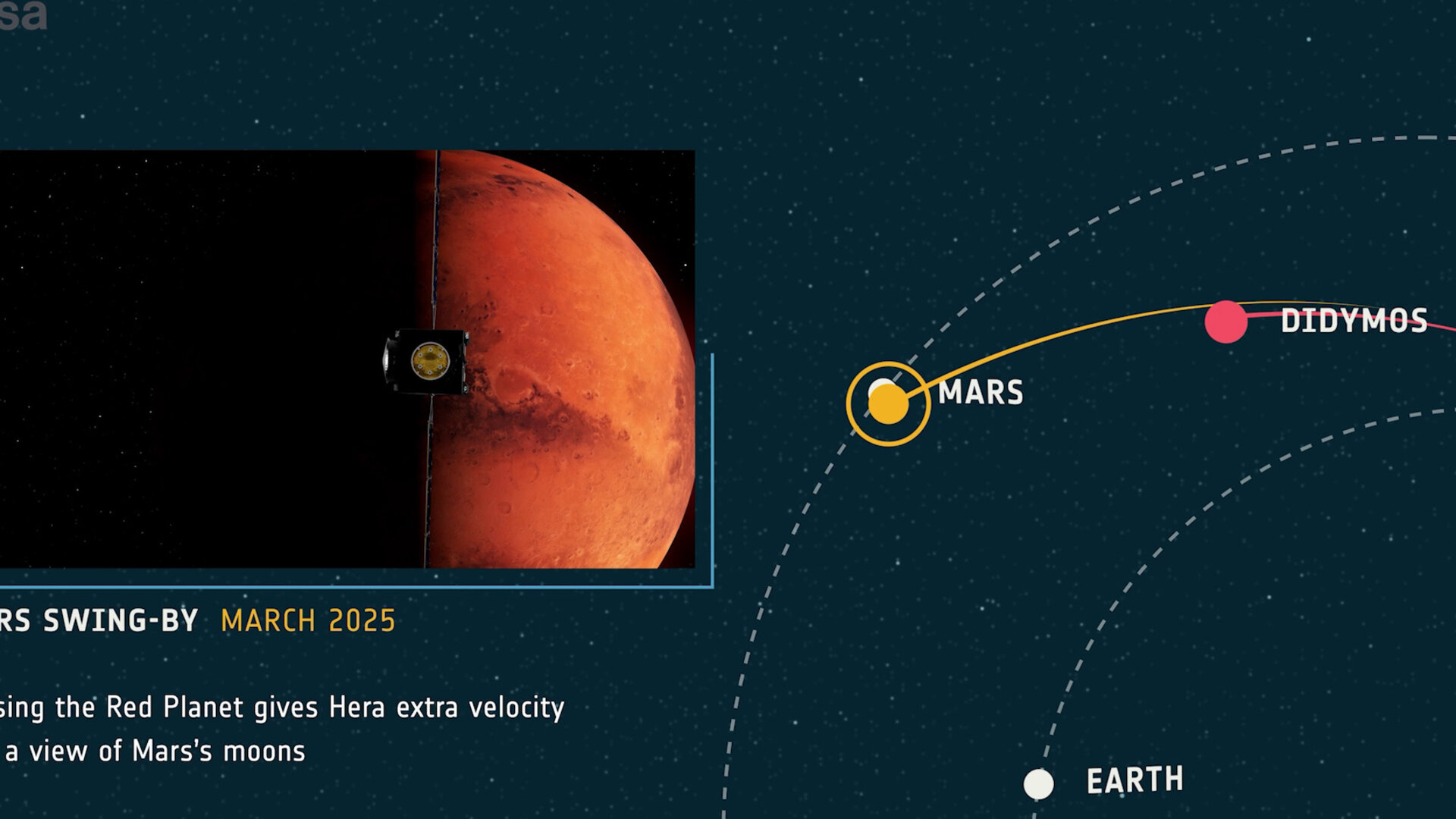
Access the video
Hera will perform a second deep space manoeuvre in February 2026. An ‘impulsive rendezvous’ in October 2026 will bring Hera into the vicinity of the Didymos asteroid system. The spacecraft will begin its detailed survey of the moonlet Dimorphos in 2027, which will turn the 151 m asteroid into one of the most studied objects in the Solar System.
A smooth start and a bright future

Reflecting on the mission so far, Hera Flight Operations Director Ignacio Tanco noted that while the team has faced a number of challenges expected, as is expected with every launch, Hera’s Launch and Early Orbit Phase (LEOP) has been without any major issues: “I would like to express my gratitude to all the teams involved in the preparation and execution of this first phase of the Hera mission. Hera went through a tense and improbable launch, but together we have converted that into a very smooth and successful LEOP.”

As Hera enters its approximately two-month Near-Earth Commissioning Phase, Hera Mission Manager Ian Carnelli expressed his thanks for the dedication shown by everyone involved in the mission: “Hera is an incredible mission: there is never a dull moment. Design, development, launch – every stage of the mission threw challenges and surprises at us, but everything has gone even better than I could have hoped. I could have never dreamt of a better team. I would like to take this opportunity to thank everyone involved from the bottom of my heart for the incredible effort. I cannot wait to continue this adventure.”
“Didymos, here we come.”

Hera’s first images offer parting glimpse of Earth and Moon
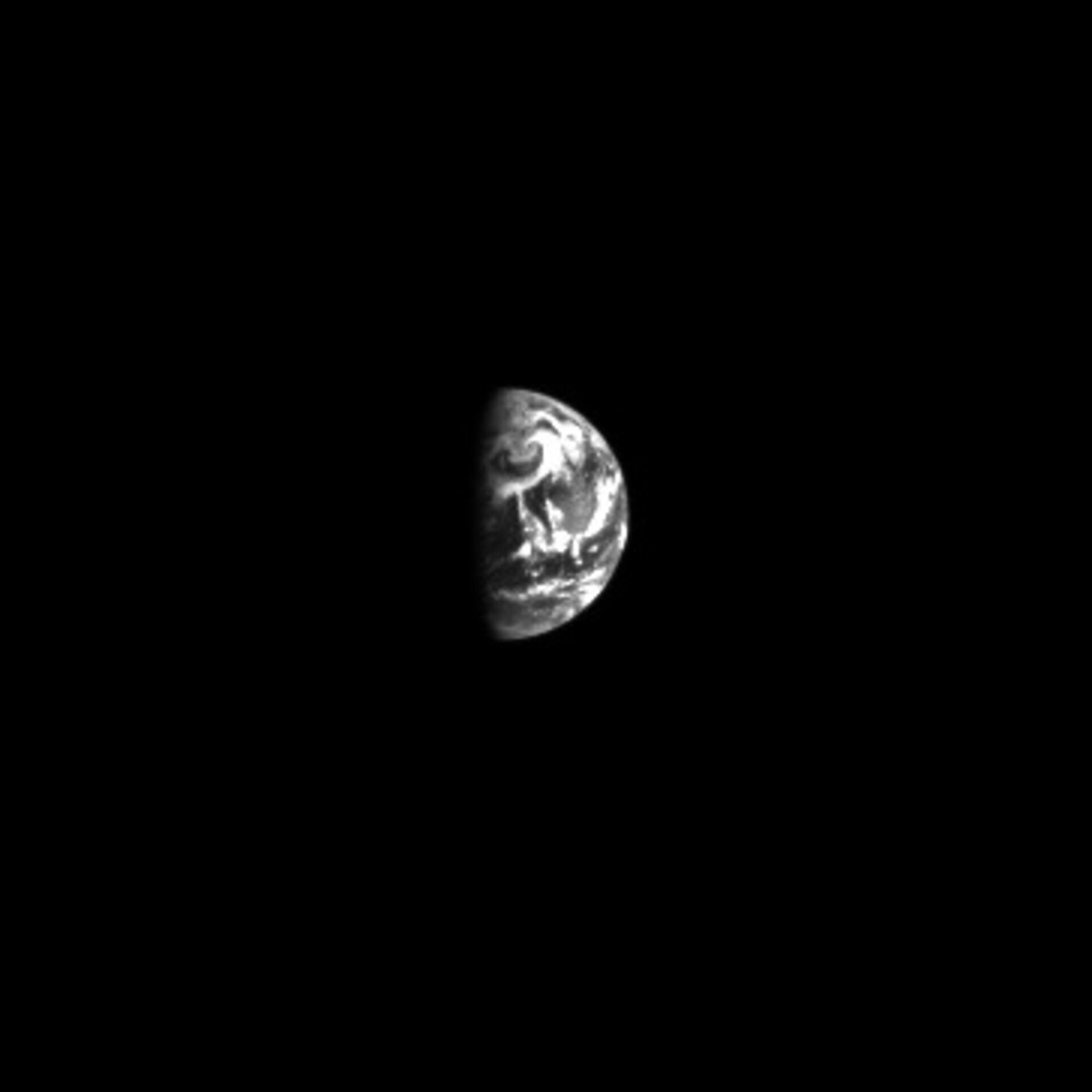
ESA’s Hera mission for planetary defence has taken its first images using three of the instruments that will be used to explore and study the asteroids Dimorphos and Didymos.
Following a successful launch on 7 October 2024, Hera’s instruments were switched on for the first time as part of the spacecraft’s ongoing Near-Earth Commissioning Phase. On Thursday 10 October and Friday 11 October, Hera’s asteroid deck, which houses the spacecraft’s instruments, was pointed back towards our planet and three of its instruments captured their first images of Earth and the Moon from a distance of more than one million km.
[A] Asteroid Framing Camera, AFC

Hera’s Asteroid Framing Camera (AFC) captured this farewell image of Earth (bottom left) and the Moon (centre) on 11 October from a distance of approximately 1.6 million km. Earth is oriented with north pointing upwards, with the Pacific Ocean illuminated by the Sun.
Incorporating two baffle-protected cameras for redundancy, each of Hera’s two Asteroid Framing Cameras is a 1020x1020 monochrome visible light sensor. The cameras are used both for navigation and for scientific investigation and were produced by Jena-Optronik in Germany, based on its ASTROhead design.
[B] Thermal Infrared Imager, TIRI

Hera’s Thermal Infrared Imager (TIRI) instrument captured this image of Earth and the Moon from a distance of approximately 1.4 million kilometres. Earth is in the centre of the image and oriented with north pointing upwards, showing the East coast of the USA and the Atlantic Ocean. The Moon is visible in the top right of the image.
TIRI will image the Dimorphos asteroid in the mid-infrared spectral region to chart the temperature on the asteroid’s surface. By charting the 'thermal inertia' of surface regions – or how rapidly their temperature changes – physical properties such as roughness, particle size distribution and porosity can be deduced. TIRI was supplied by the Japan Aerospace Exploration Agency, JAXA, manufactured by Meisei Electric Co. Ltd. and inherited from the instrument onboard the agency’s Hayabusa2 asteroid mission.
[D] HyperScout H

Hera’s HyperScout H instrument captured this false-colour image of Earth and the Moon from a distance of approximately 1.6 million kilometres. Earth (bottom right) is oriented with north pointing upwards, with the Pacific Ocean illuminated by the Sun. The Moon is visible in the top right of the image.
HyperScout H will observe the Dimorphos asteroid in a range of colours far beyond the limits of the human eye and help determine the asteroid’s mineral makeup. The hyperspectral imager covers the 650–950 nm wavelength range, with colours coded so that blue represents the shortest wavelengths and red represents the longest. The shoebox-sized imaging spectrometer was provided by cosine remote sensing in the Netherlands.
Quelle: ESA



